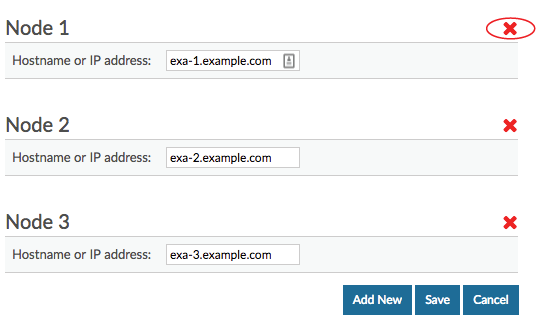Increase the capacity of your ExtraHop Explore cluster in VMware
The Explore virtual appliance for VMware is available in four configurations, each with maximum memory and datastore sizes. If your infrastructure outgrows your current Explore cluster capacity, there are three ways to increase the capacity. You can add more nodes to an existing cluster, you can create a new cluster with all new higher-capacity nodes (data is not preserved), or you can replace your existing nodes with virtual appliances that have larger capacity than your existing virtual appliances and preserve your existing data.
- Deploy the new larger-capacity Explore appliances
- Disconnect the existing Explore cluster from any connected Discover and Command appliances
- Add one newly-deployed Explore appliance to the existing Explore cluster
- Wait for your data to be reallocated throughout the new Explore cluster
- Remove the older, smaller-capacity Explore node
- Repeat this process for additional new nodes
- Connect the new Explore cluster to the Discover and Command appliances
If you simply want to add more nodes that have the same specifications as the existing nodes in your Explore cluster, see our Deploy the ExtraHop Explore Appliance with VMware guide.
| Important: | If you are creating a recordstore cluster with six or more nodes, you must configure the cluster with manager nodes. For manager node instructions, see Deploying manager nodes. |
To replace an existing cluster with larger-capacity nodes where you do not need to preserve the existing stored records, you similarly deploy new nodes and create a new cluster. You then disconnect the existing cluster from any ExtraHop Discover or Command appliances and connect the new cluster to your ExtraHop Discover or Command appliances.
Before you begin
- Ensure that all appliances in the Explore cluster have the same appliance specifications. Disparate node types are allowed only during a migration procedure.
- You must register every new Explore appliance with a product key before you can add the appliance to the Explore cluster.
- Depending on the number of nodes and the amount of data stored in the Explore cluster, it can take up to a week after you change the replication level or remove an Explore node from the cluster for all indices to display a Green status.
Deploy the new Explore appliances in VMware
Disconnect all Explore nodes
This procedure stops any new data from being sent and stored on the Explore cluster that will be replaced.
Before you begin
If the Explore appliance connections are managed from a Command appliance, you must perform this procedure from the Command appliance instead of from each Discover appliance.Change the replication level on the Explore cluster
This procedure ensures that data is replicated across the new nodes correctly and quickly.
- Log in to the Administration settings on one of the nodes in the Explore cluster.
- In the Explore Cluster Settings section, click Cluster Data Management.
- In the Replication section, select 1 from the Replication Level drop-down menu, and then click Update Replication Level.
- If Shard Reallocation is OFF, click Enable Shard Reallocation.
- Return to the Status and Diagnostics section and click Explore Cluster Status.
- Wait for all of the Status fields in the Indices table to display Green before continuing to the next procedure.
Join the new Explore node to the existing cluster
In this procedure, you will join one of the new Explore nodes to the existing cluster. Do not join multiple new nodes at this stage.
- Log in to the Administration settings on one of the new Explore nodes.
- In the Cluster Settings section, click Join Cluster.
- In the Host field, type the hostname or IP address of any node in the existing Explore cluster and then click Continue.
- Note the information listed for Fingerprint. Verify that the fingerprint that appears matches the fingerprint of the Explore appliance you are joining.
- In the Setup Password field, enter the password for the setup user.
- Click Join.
- Return to the Status and Diagnostics section and click Explore Cluster Status.
- Wait for all of the Status fields in the Indices table to display "Green" before continuing to the next procedure.
Remove the old Explore node from the existing cluster
In this procedure, you will remove the Explore node you are replacing. Do not remove multiple nodes at once.
- Log in to the Administration settings on the Explore appliance that you want to remove from the Explore cluster.
- In the Explore Cluster Settings section, click Cluster Members.
- In the Actions column, click Leave Explore Cluster. Leaving an Explore cluster deletes all saved data on the Explore node.
- Click OK.
- Log in to the Administration settings on an Explore node in the Explore cluster.
- In the Status and Diagnostics section and click Explore Cluster Status.
- Wait for all of the Status fields in the Indices table to display "Green" before continuing to the next procedure.

Thank you for your feedback. Can we contact you to ask follow up questions?